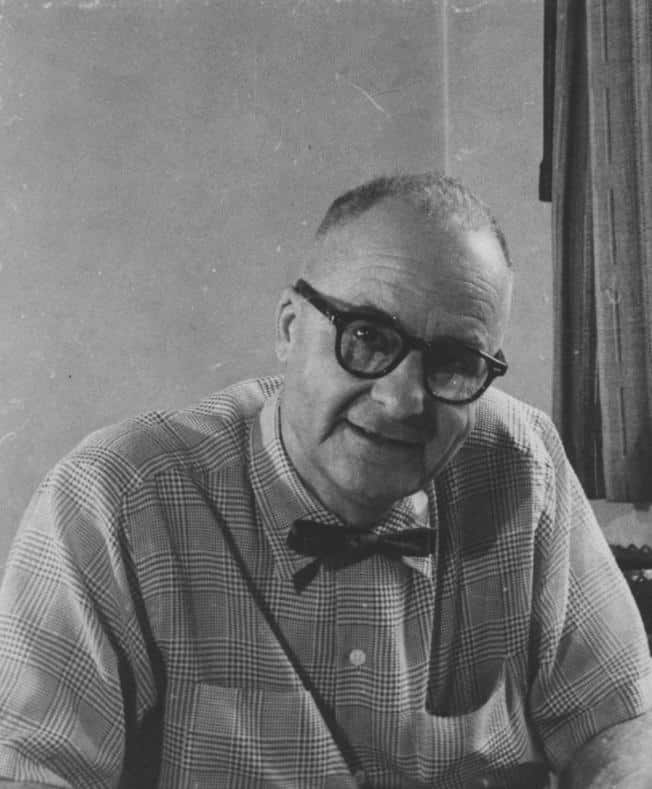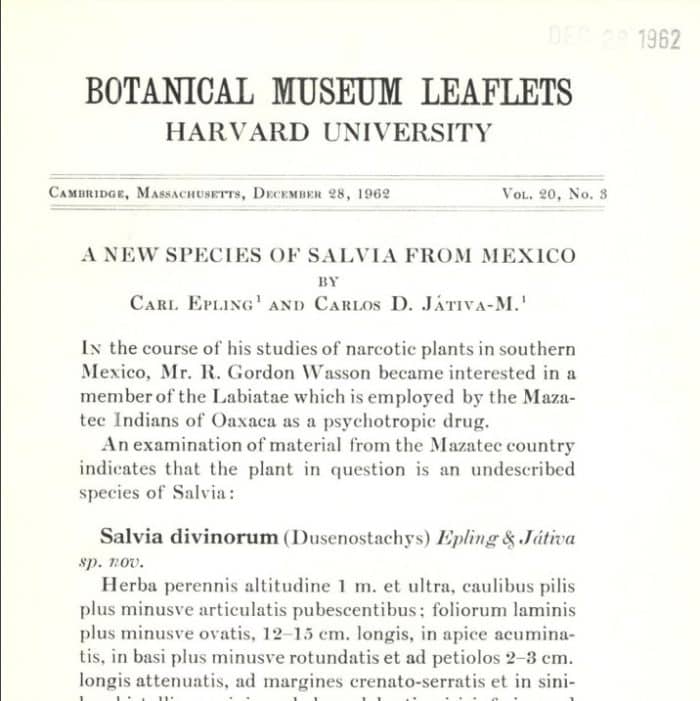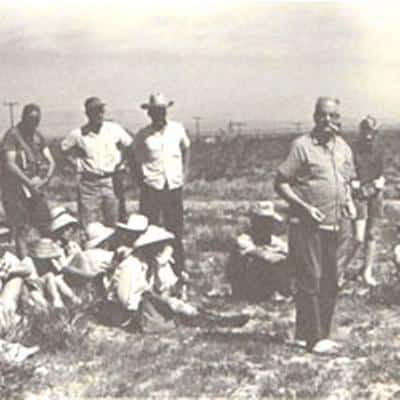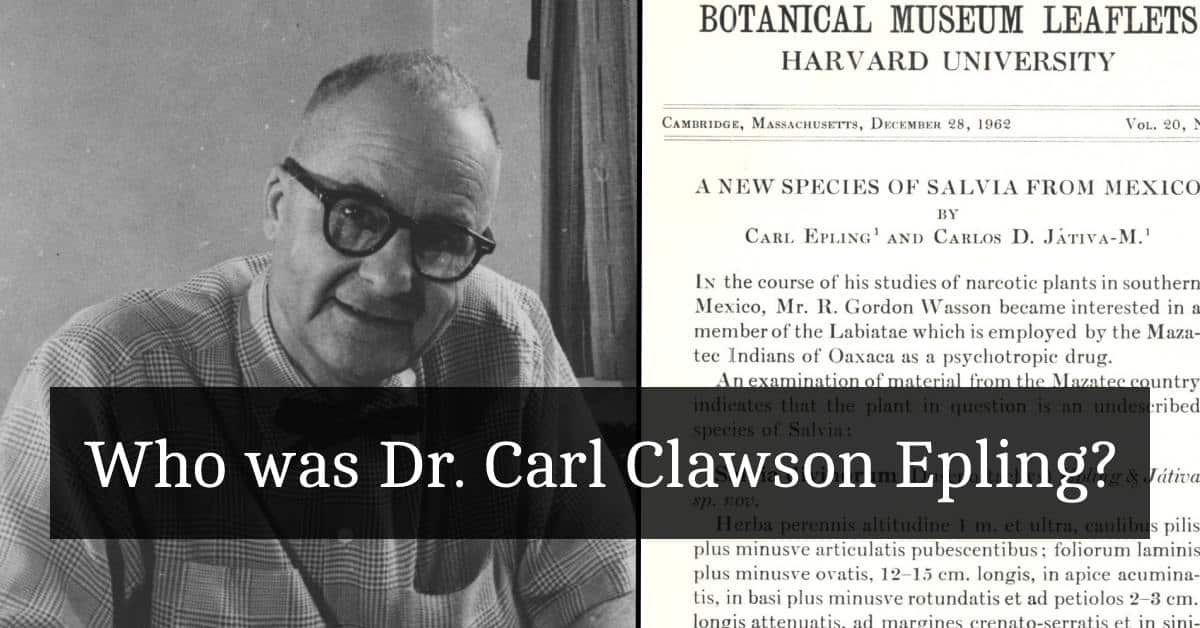Carl Clawson Epling (1894-1968) was an American botanist and taxonomist who made significant contributions to the study of Salvia divinorum, a psychoactive plant species native to Mexico. Epling’s work on Salvia divinorum helped to bring the plant to the attention of the scientific community and laid the groundwork for later research on its chemical constituents and potential therapeutic uses. Epling, along with his colleague Carlos Játiva, are known as the first to scientifically identified and described salvia divinorum.
Epling first encountered Salvia divinorum during his botanical expeditions in Mexico in the 1950s. Along with his colleague Carlos D. Játiva, Epling conducted extensive research on the plant’s morphology, distribution, and traditional uses by the indigenous Mazatec people of Oaxaca, Mexico. They documented the plant’s psychoactive effects, which they attributed to the presence of an unidentified compound in the plant’s leaves.

In 1962, Epling and Játiva published a scientific paper titled “A New Species of Salvia from Mexico” in the journal Botanical Museum Leaflets of Harvard University. The paper described Salvia divinorum as a new species of plant and documented its traditional use and psychoactive effects. Their paper helped to bring Salvia divinorum to the attention of the scientific community and sparked interest in the plant’s pharmacology and potential therapeutic uses.
One of the most significant contributions of Epling and Játiva’s work on Salvia divinorum was their documentation of the plant’s traditional use by the Mazatec people. The Mazatec have used Salvia divinorum in shamanic rituals for centuries, consuming the plant’s leaves to induce altered states of consciousness and facilitate spiritual experiences. Epling and Játiva’s research helped to shed light on the cultural significance of the plant and its role in indigenous healing practices.

Epling and Játiva’s work on Salvia divinorum also laid the groundwork for later research on the plant’s chemical constituents and pharmacological effects. In the years following their paper, researchers began to study the plant’s psychoactive effects in more detail, eventually identifying salvinorin A as the compound responsible for the plant’s hallucinogenic effects.
Salvinorin A is a potent kappa-opioid receptor agonist, meaning that it interacts with the kappa-opioid receptor in the brain to produce its psychoactive effects. Unlike other psychoactive compounds such as psilocybin or LSD, salvinorin A is not a serotonin agonist and does not produce effects that are similar to those of classical psychedelics. Instead, it produces unique and often intense dissociative and hallucinogenic effects that can last from a few minutes to several hours.
Today, Salvia divinorum is recognized as a potent psychoactive plant species with unique pharmacological properties. It continues to be the subject of ongoing research in the fields of ethnobotany, pharmacology, and neuroscience. Researchers are investigating the potential therapeutic applications of Salvia divinorum and its chemical constituents, particularly salvinorin A, which has been shown to have promising effects in the treatment of depression, addiction, and chronic pain.
Epling and Játiva’s work on Salvia divinorum helped to bring attention to this remarkable plant species and contributed to our understanding of its cultural, botanical, and pharmacological significance. Today, their legacy lives on in the ongoing research and exploration of the many mysteries of Salvia divinorum.
In conclusion, Carl Clawson Epling was a pioneering botanist and taxonomist whose work on Salvia divinorum helped to bring attention to this unique and little-known plant species. Epling’s documentation of the plant’s traditional use and psychoactive effects laid the groundwork for later research on its chemical constituents and potential therapeutic applications.

Today, Salvia divinorum is recognized as an important plant species with a rich cultural history and promising therapeutic potential. The plant’s psychoactive effects have led to its use in spiritual and shamanic practices, as well as its potential use in the treatment of various medical conditions.
In recent years, research has been conducted on the potential of salvinorin A as a treatment for addiction. Studies have shown that salvinorin A may be effective in reducing the addictive effects of drugs such as cocaine, alcohol, and nicotine. Research has also been conducted on the plant’s potential to treat depression and anxiety, with promising results. Salvinorin A has been shown to have rapid-acting antidepressant effects, and some researchers believe that it may be useful in treating treatment-resistant depression.
Despite the potential therapeutic applications of Salvia divinorum, the plant remains largely unstudied due to legal restrictions on its use and possession. In the United States, some states have classified Salvia divinorum as a Schedule I controlled substance, making it illegal to possess or use. This has made it difficult for researchers to conduct clinical studies on the plant’s effects and potential uses in those states.
Despite these challenges, there is growing interest in the potential therapeutic applications of Salvia divinorum, and research is ongoing. Epling’s work on the plant helped to lay the foundation for this research, and his legacy lives on in the ongoing exploration of the many mysteries of this unique and remarkable plant species.
In conclusion, Carl Clawson Epling made significant contributions to the study of Salvia divinorum, documenting the plant’s traditional use and psychoactive effects and laying the groundwork for later research on its chemical constituents and potential therapeutic applications. Epling’s work helped to bring attention to this important and little-known plant species, and his legacy lives on in the ongoing exploration of its many mysteries.
The story of Eplings & Játivas journey into Mexico
In the early 1950s, Carl Epling and Carlos D. Játiva set out on an expedition to explore the flora of Mexico. Epling was a botanist and professor at the University of California, Los Angeles, while Játiva was a botanist and professor at the National Autonomous University of Mexico.
Their journey took them to many remote areas of Mexico, including the Sierra Mazateca region in the state of Oaxaca. There, they met with local curanderos, or traditional healers, who used a plant called Salvia divinorum in their rituals. The curanderos referred to the plant as “Ska Maria Pastora,” which means “leaf of the shepherdess who is the Virgin Mary.”
Epling and Játiva were intrigued by the plant and its effects, which they observed during a ceremony conducted by a curandero. They collected samples of the plant and brought them back to their respective universities for study. However, their journey was not without challenges.
The Sierra Mazateca region was rugged and difficult to access. Epling and Játiva had to trek through dense forests, climb steep mountains, and ford rivers to reach their destinations. They also faced language barriers, as few people in the region spoke English or Spanish fluently. Despite these challenges, Epling and Játiva persisted in their quest to learn more about the plants of Mexico.
Once they had collected samples of Salvia divinorum, Epling and Játiva began to study the plant in detail. They found that it contained a powerful psychoactive compound called salvinorin A, which is responsible for the plant’s hallucinogenic effects. Epling published a paper on the plant in the journal “Madroño” in 1962, naming it Salvia divinorum. Játiva also published several papers on the plant.
Epling and Játiva’s discovery of Salvia divinorum was significant because it was the first time that the plant had been scientifically described and named. It also brought attention to the traditional use of the plant by indigenous peoples in Mexico. Today, Salvia divinorum is known throughout the world as a psychoactive plant that can induce powerful visions and altered states of consciousness. However, it is also used by some traditional healers in Mexico for medicinal purposes.
Epling and Játiva’s journey to Mexico was a landmark event in the study of plant medicines. By venturing into remote regions and talking with local healers, they were able to discover new plants and learn about their traditional uses. Their work paved the way for future research into the healing properties of plants and helped to preserve traditional knowledge that might otherwise have been lost.
Sources:
- Epling, C., & Játiva-M. C. (1962). A new species of Salvia from Mexico. Madroño, 17(6), 212-214.
- Valdés, L. J., Díaz, J. L., Paul, A. G., & Litinas, E. (1983). Ethnopharmacology of Ska María Pastora (Salvia divinorum, Epling and Játiva-M.). Journal of Ethnopharmacology, 7(3), 287-312.
- Valdés III, L. J., Hatfield, G. M., Paul, A. G., Koreeda, M., & Glick, S. D. (2001). Antagonism of pharmacologically-induced subjective effects of DMT by ketanserin. Journal of Psychoactive Drugs, 33(3), 213-216.
- Valdés III, L. J., Butler, W. M., Hatfield, G. M., Paul, A. G., Koreeda, M., & de Rios, M. D. (2002). Salvia divinorum: an hallucinogenic mint which might become a useful tool for the treatment of depression. Journal of Psychoactive Drugs, 34(2), 235-244.
- Gómez-Cruz, E. D., & Estrada-Camarena, E. M. (2018). Salvia divinorum: from recreational hallucinogenic use to analgesic and anxiolytic properties. Journal of Traditional and Complementary Medicine, 8(2), 284-293.
- Loizaga-Velder, A., & Verres, R. (2014). Therapeutic effects of ritual ayahuasca use in the treatment of substance abuse—qualitative results. Journal of Psychoactive Drugs, 46(1), 63-72.
- Cox, P. A. (1997). The ethnobotanical approach to drug discovery: strengths and limitations. In F. H. Fréderich, J. Miklosy, & L. M. Weiner (Eds.), Ethnobotany and the search for new drugs (pp. 4-23). Ciba Foundation Symposium 185.
- Shi, Y. G., Zhang, X. H., Wu, M. S., Wang, X. F., Yang, Y. Q., & Liu, Y. (2019). Rapid-acting antidepressant-like effects of salvinorin A and its derivatives in animal models. Journal of Psychopharmacology, 33(5), 575-583.
- Johnson, M. W., MacLean, K. A., Reissig, C. J., Prisinzano, T. E., & Griffiths, R. R. (2011). Human psychopharmacology and dose-effects of salvinorin A, a kappa opioid agonist hallucinogen present in the plant Salvia divinorum. Drug and Alcohol Dependence, 115(1-2), 150-155.
- Addy, P. H. (2012). Acute and post-acute behavioral and psychological effects of salvinorin A in humans. Psychopharmacology, 220(1), 195-204.
- Baggott, M. J., Coyle, J. R., & Erowid, E. (2013). Use patterns and self-reported effects of Salvia divinorum: an internet-based survey. Drug and Alcohol



